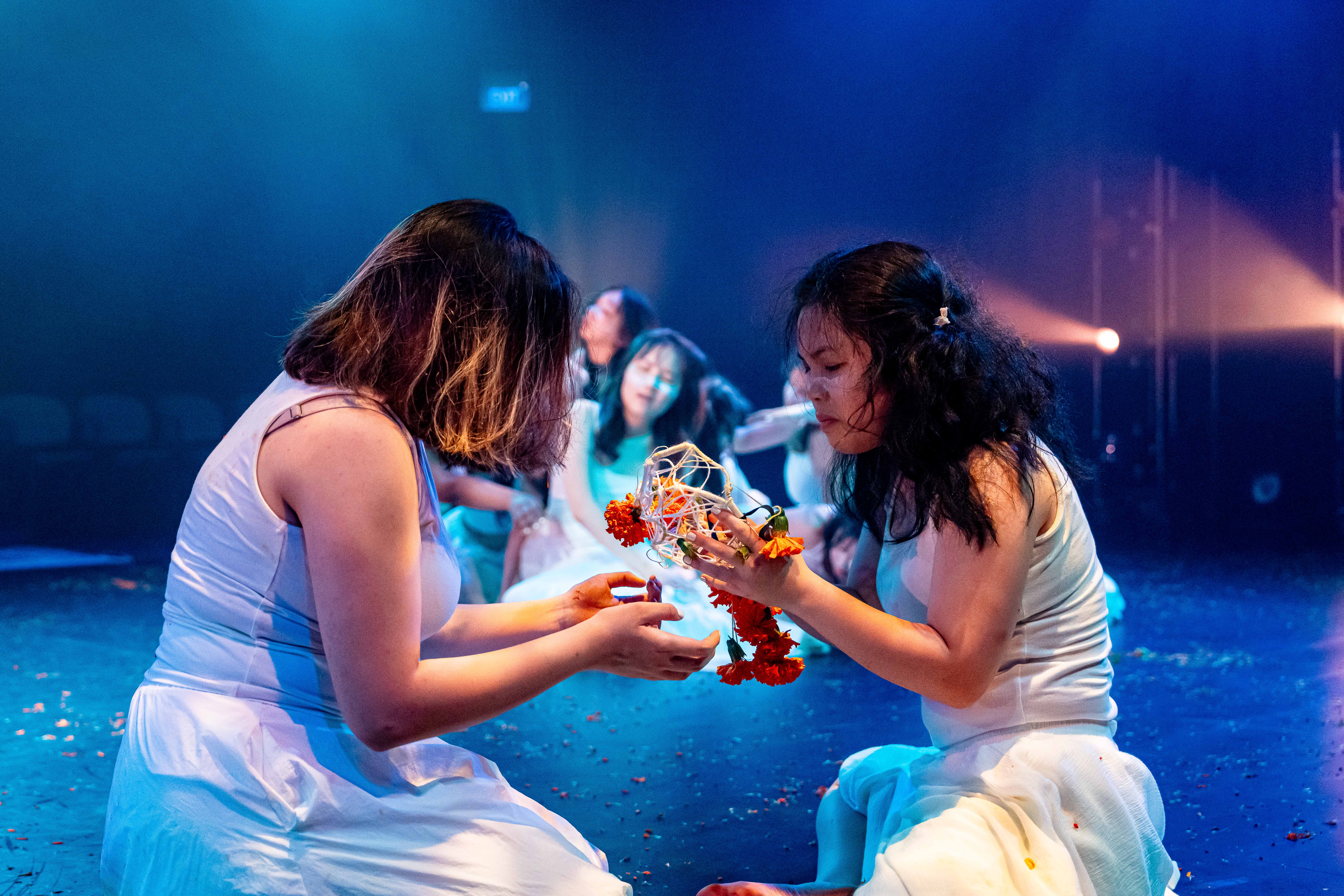剧评:Dancing with the Ghost of My Child
(PHOTOS BY ALEX CHUA)
起舞是治愈的开始—— 观“Dancing with the Ghost of My Child”
开场前,一位头戴花冠的表演者在等待入场的观众群间穿梭;开场没多久,这位表演者的花冠被其他角色们疯狂剥夺、撕扯、撒落舞台各方。
这是一场关于绝望与救赎的祭祀,由南洋艺术学院表演课程荣誉学士的学生们演出,剧本由其中四位学员联合编写。“Dancing”以肢体与音乐演绎,表演者们穿着白色的长裙,脸上抹着白色油彩,他们身上的白衣饰渐渐被花瓣与汗水玷污,我坐在地板的坐垫上(有的观众坐在椅子上),近距离感受着表演者们的能量。他们跺脚击地,观众会感受到阵阵震动;他们向观众撒花瓣、在空间里呐喊,以身体能量直接“打动”观众。“Dancing”是表演者们对“创伤”课题的探索,例如在其中一幕,有一角色阐述自己被性骚扰的经历,她被对方要挟、跟踪,但无论向警方或学校求助,她都无法获得任何帮助,原因是对方对她造成的行为“不足够严重”。剧中的所有角色都是受害者,他们试图夺回话语权,却总在夺得权力之时、在施展暴力之时痛苦不堪—— 他们从未想要以暴力相待施暴者,然而在这个现实社会里她们却不得不那么做。因为大部分表演者们都是女性,每当这些女子起舞、拍打自身、呐喊时,都让人想起希腊悲剧里那些受了酒神的操纵,被赋予神力而狂热的女子们。于是观众也感受得到这些年轻人们正在经历的种种混乱与创伤—— 通过肉身的运动与运作,观众得以切身地感受到他们的痛与苦,也因此能够对他们产生同理心。
导演们Noor Effendy Ibrahim 和 Ruby Jayaseelan在剧中建立强烈鲜明的意象,再肆意破坏意象,以达到震撼观众心灵的效果。例如,台上挂着三袋清水,在整场演出中缓缓滴水,表演者们时而会用清水抹身,但他们始终净化不了内心的痛苦。例如,撒满舞台的花瓣散发浓郁的花香,充斥舞台,却无法让这些角色们获得疗愈。例如,现场演唱的甘美朗歌手Rosemainy Buang悠悠唱起歌曲,然而理应治愈心灵的歌曲却让角色们齐齐倒地抽搐。
于是观众感受到界线被模糊了:疯狂与理性、绝望与希望、天堂与炼狱…… 导演把二元对立的元素交织混杂,建立了戏剧张力,也成功让观众感受到,人性里的理性如何蕴藏着疯狂、所有的希望其实都是绝望、天堂如何也是炼狱……
表演者们的肢体能力未必都掌握得很好,但他们愿意为观众坦诚他们的恐惧与哀伤,且毫无保留地释放力量,好久没有看到那么摄人心魄、那么赤诚的表演了,颇有久旱逢甘露的感觉。原来肉身是我们互相连结的桥梁,这也许是这些表演者们想要寻找的治愈。“Dancing”让这群学生们通过肉身去面对“创伤”,而这正是剧场的可贵之处:让这些寻求治愈的灵魂知道,有这么一个空间,让人们可以一起进行一场一场的祭祀,一起祈求,愿一切的深伤都可以愈合成希望。
关于演出:2025年1月10日,8PM,NAFA Studio Theatre,Noor Effendy Ibrahim, Ruby Jayaseelan, ANTARMUKA 和 南洋艺术学院、M1艺穗节呈现
Co-directors: Noor Effendy Ibrahim and Ruby Jayaseelan
Performed in English by Bachelor of Arts (Honours) Performance Making students
点击进入M1艺穗节网页:https://2025.singaporefringe.com/Dancing-with-the-Ghost-of-my-Child
Dancing As The Way To Healing— Reviewing “Dancing with the Ghost of My Child”.
Before the house opened, a performer donning a crown of flowers moved amongst the audience who were waiting to enter; shortly after the performance began, that same performer's crown was feverishly stripped, torn, and scattered across the stage by the other characters.
“Dancing with the Ghost of My Child” is a ritual of struggle and redemption, performed by the students of the BA (Hons) Acting Program from the Nanyang Academy of Fine Arts, the script co-written by four of the students. “Dancing” is a physical and lyrical performance. The performers were dressed in gowns of white, their faces smeared with white paint, and as the show went on, their dresses were gradually sullied by flower petals and sweat. I sat on a cushion on the floor (some audience were seated in chairs) and could feel the energy of the performers up close: as they stamped their feet they sent vibrations that shook our core; we watched as they scattered flower petals on us; they chanted in the small theatre space, “moving” the audience directly with their physical energies. “Dancing” is an investigation into the subject of trauma: in one scene a character narrated a story of sexual harassment by someone who blackmailed and stalked her, and yet she was unable to get any help from the police, because the behavior of the perpetrator was deemed not offensive enough to be dealt with... All the characters in the play were suffering, and as they tried to reclaim their voices, they often suffered when they had to commit acts of violence-- they never wanted to be violent towards their abusers, but they were compelled to do so in the real world. Most of the performers were women, and every time these women danced, slapped themselves, and hollered, one is reminded of the women who were endowed with divine powers by Dionysus in Greek tragedies. The audience thus were able to experience the turmoil and trauma that these youths were going through-- through the physical movement of the bodies, the audience was able to feel their pain and suffering, and to empathize with them.
The directors (Noor Effendy Ibrahim and Ruby Jayaseelan) built strong imageries and then destroyed them wilfully, creating strong, viceral effects on the audience. There were three bags of water hanging on the stage, trickling slowly throughout the show, and the performers would occasionally use the water to bathe their bodies, but they could never purge themselves of their emotional pain. The flower petals scattered all over the stage emitted a thick floral scent that permeated the stage, but failed to bring restoration to the characters. Gamelan musician Rosemainy Buang sung live, yet the songs that should have healed the soul sent the characters to the ground convulsing in grief.
Thus the audience perceives that the boundaries between madness and rationality, between despair and hope, between heaven and purgatory... are all blurred. The director's attempt to meld the binaries creates dramatic tension, and successfully demonstrated how madness is embedded in rationality, how all hope has to be despair, and how paradise is a purgatory.
The performers may not have perfect mastery of their physical abilities, but their willingness to reveal their fears and sorrows to the audience, and their unreserved strength and courage, made for a gripping and emotional performance, and I felt that it has been a long time since I watched a work of such degree of honesty and sincerity. It appears that the physical body is the bridge that connects us to each other, which may be the closure that these performers are seeking. “Dancing” enabled the students to face “trauma” in its complexity through their physical body, and this is precisely what is so valuable about theater: to let all those who seek healing know that there is a space where people can come together and collectively wish that all deep wounds, pierced by acts of hope, can also be healed.
The reviewer watched the show on 10th January 2025, 8PM, at the NAFA Studio Theatre. This performance was presented by Noor Effendy Ibrahim, Ruby Jayaseelan, ANTARMUKA and Nanyang Academy of Fine Arts, at the M1 Fringe Festival 2025






Comments
Post a Comment